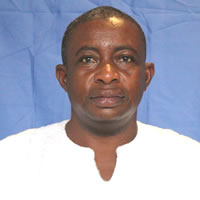Physical Characteristics
Location and Size
The Daffiama-Bussie-Issa District is one of the newly created districts carved out of the then Nadowli District with its capital at Issa. It covers a total land area of 1,456.16930Sqkm which represents 7% of the total land area of the Upper West Region. It is bordered to the South by Wa Municipal Assembly, to the North by Jirapa and Sissala West District Assemblies to the West by Nadowli/Kaleo District Assembly and to the East by Wa East District Assembly.
It is located along the main Wa–Funsi–Wellembelle road. The District is mainly accessible by road from all the areas that border it. From the National capital Accra, access to Daffiama-Bussie-Issa District is through the Regional Capital, Wa. The distance between the District and the Regional Capital covers about 40 km. The location of the District promotes trade between the Districts surrounding it. Adversely the District faces the threat of cattle rustling due to the influx of the Fulani herdsmen, a situation which active steps must be taken to deal with. Sadly, the Daffiama-Bussie-Issa District is one of the most deprived of the eleven districts in the Upper West Region.
Relief and Drainage
The topography of the District is low lying and undulating at altitudes ranging between 150m-300m above sea level though some parts average 600m. The District is close to the Wahabu River and several ephemeral streams, which assist to enhance livelihood of the people. This limited number of rivers and streams coupled with the seasonal drought seriously hampers dry season farming resulting in low output levels and food insecurity that is experienced almost every year.
Vegetation and Climate
The District lies within the tropical continental and guinea savannah woodland characterized by shrubs and grassland with scattered medium sized trees. Some economic trees found in the District are kapok, shea, baobab, mango and dawadawa which are resistant to both fire and drought. These trees provide a major source of income to households particularly women who play important roles in the provision of household needs. These economic trees provide a potential for the establishment of processing industries to increase employment opportunities for the people.
The District has a mean annual temperature of 32oC and a mean monthly temperature ranging between 36oC around March to 27oC around August. The District lies within the tropical continental zone and annual rainfall is confined to 6 months that is May to September and is also unevenly distributed. Mean annual rainfall is about 110mm with its peak around August. Between October and March there is virtually no rain and this long dry season is made harsh by the dry north-easterly Harmattan winds.
This unfavourable climatic condition promotes only rain fed agriculture and has been the major underlying reasons for the chronic out migration of the youth to the southern part of the country which is a major problem facing the District. This climatic condition calls for the construction of dams and dug outs to support irrigation agriculture to reduce migration during the dry season.
Geology and Soils
The main types of rocks found in the District are granite and some basement complex to the east. These rocks hold a considerable quantity of water, which is a good potential for the drilling of boreholes and sinking of wells.
The soil types are laterite, sandy and sandy loam (savannah ochrosols). They are generally poor in organic matter and nutrients as a result of the absence of serious vegetative cover due to bush burning, overgrazing, over cultivation and protracted erosion. Consequently the soils are heavily leached. Relatively fertile soils (sandy loams) occur around Issa and Tabiesi and support crops such as yams, cereals, legumes and rice (Meteorological Service Station¬- Wa, 2013).
Environmental Situation
Condition of the Natural Environment
Traditional belief systems and human activities in the District tend to regard the land as a reservoir of unlimited resources. Human activities particularly annual routine bush burning, indiscriminate tree felling for fuel wood, over grazing by livestock, sand, gravel and stone winning have led to deceasing the vegetation cover and increasing soil erosion and depletion of soil fertility.
Other factors such as road construction, bad farming practices’, and farming along water sources have also resulted in the silting of water bodies like dams and ponds and destruction of vegetation protecting the water bodies. Recent efforts by government under the Ghana Social Opportunities Project (GSOP) component of climate change programme on tree planting in all dry areas of the country has come as a relief to help the District fight the increasing pace of desertification.
There is also the growing awareness of the need to maintain and sustain the environment. A manifestation of this is the existence of women groups in agro-forestry in the District. Individuals have also adopted the habit of planting trees around their buildings. Developing economic trees plantations e.g. Cashew, Mangoes has also gained popularity over the years. Despite the growing awareness on environmental conservation, a lot needs to be done in view of the Districts threat to desertification due to both human and natural factors.
Condition of the Built Environment
There is a gradual improvement in the housing sector in the District. Most of the traditional house types with earth roofs are giving way to land Crete and block houses with zinc and aluminium roofing sheets. There has also been remarkable improvement in the quality, quantity and design of privately owned houses. The use of cement blocks in construction of houses has increased and the provision of wide windows has improved ventilation in the houses.
This has a positive implication on the health of the people since it will minimize the spread of diseases like Tuberculosis, CSM and other air borne diseases which are on the ascendancy in the Region. With the creation of the District, some residential buildings for staff especially for the education and health sectors have been rehabilitated. The District Assembly is currently constructing staff quarters to provide suitable accommodation for departmental staff.
The average room occupancy ratio in the district is 1:3. This ratio suggests a relatively low pressure on housing facilities, which could partly be accounted for by the high out-migration of the youth from the area. The low room occupancy ratio is, however, a good potential for proper management of the poor environmental hygiene and sanitation situation in communities. To ensure that building codes and regulations are adhered to, the district is in the process of developing a physical planning scheme for the district capital which will be replicated in all major towns in the district in future.
Date Created : 4/9/2018 7:25:12 AM




